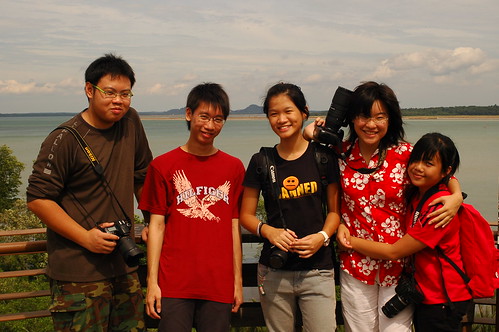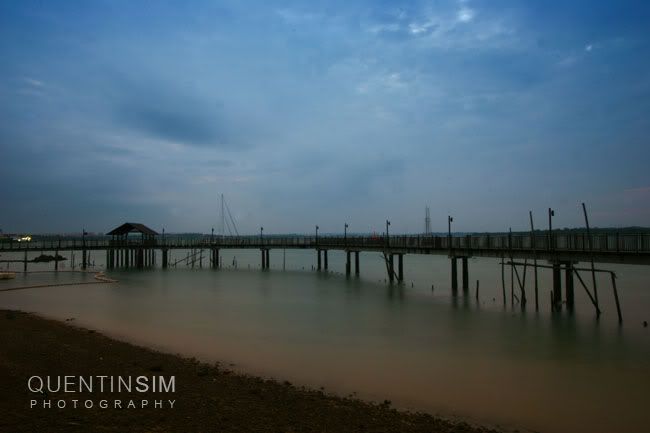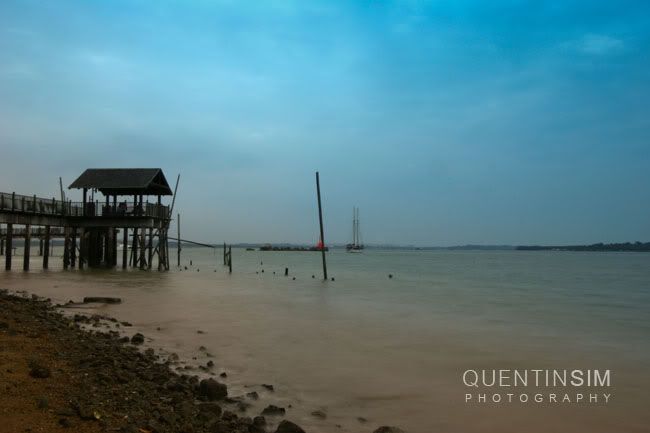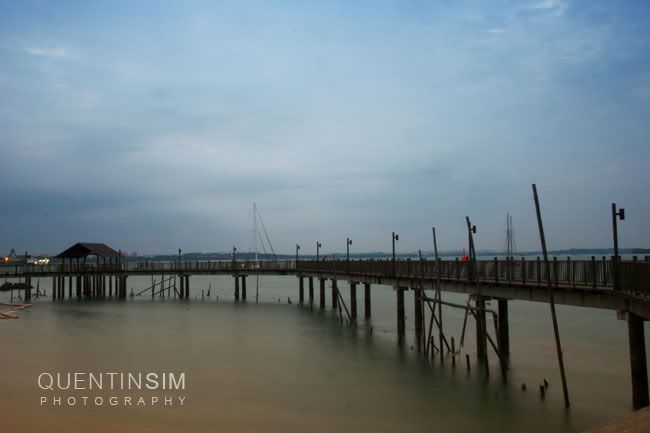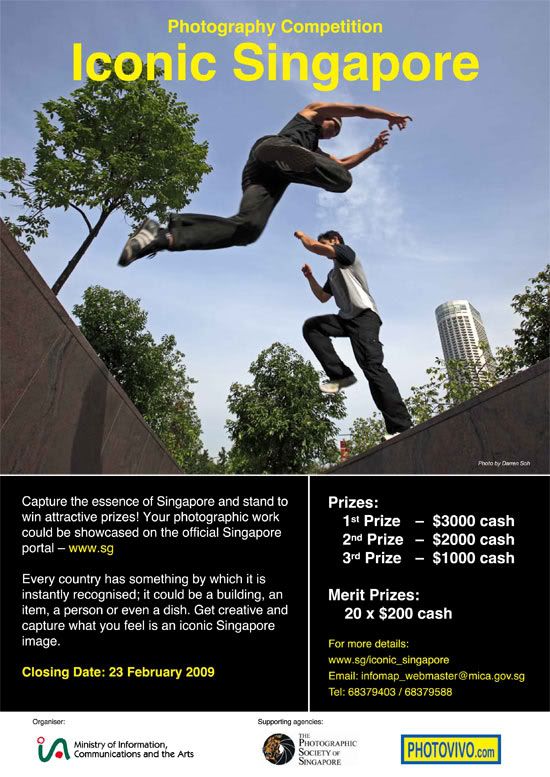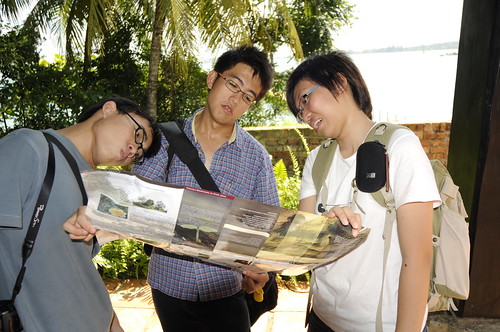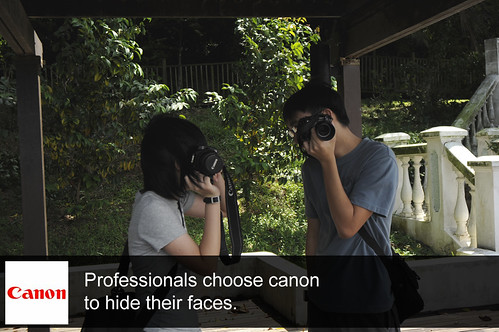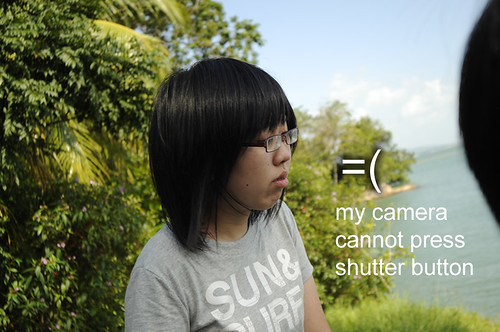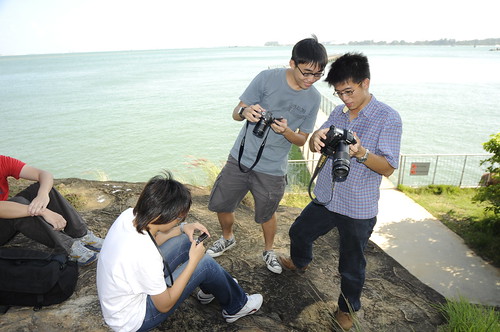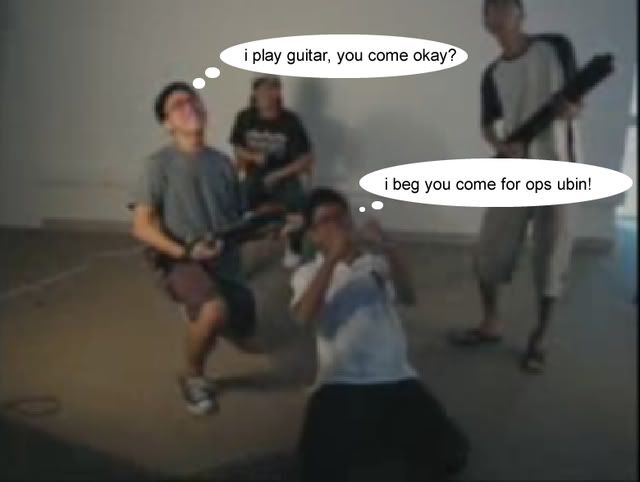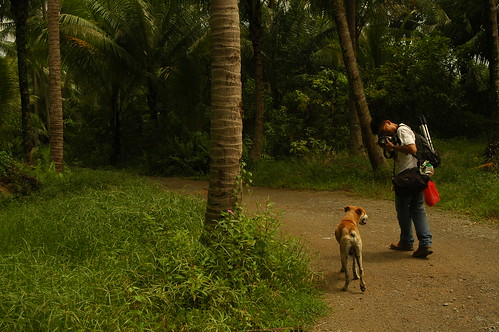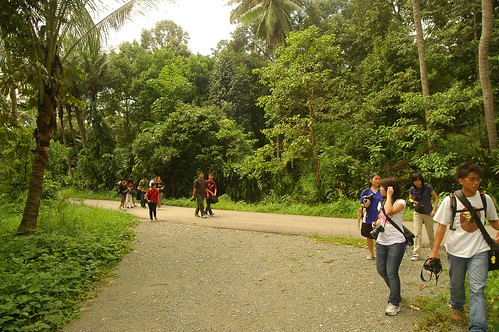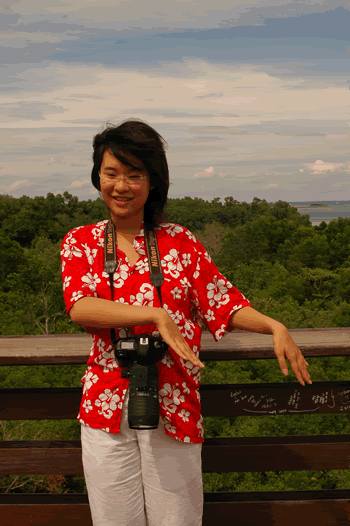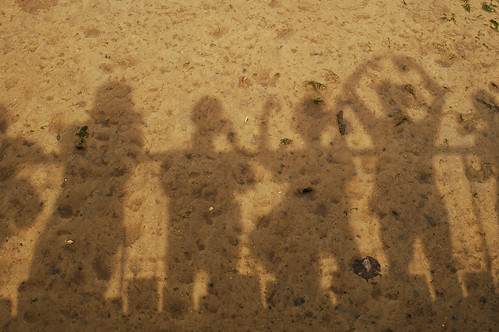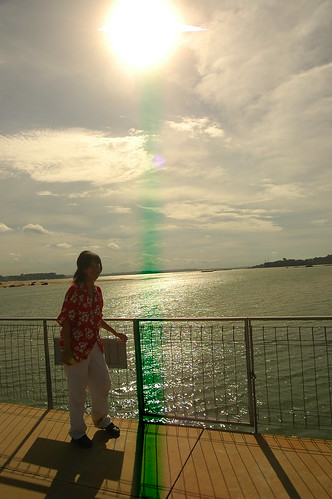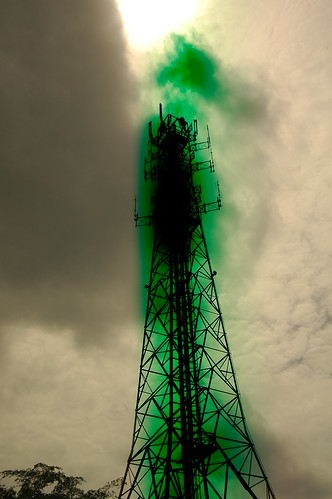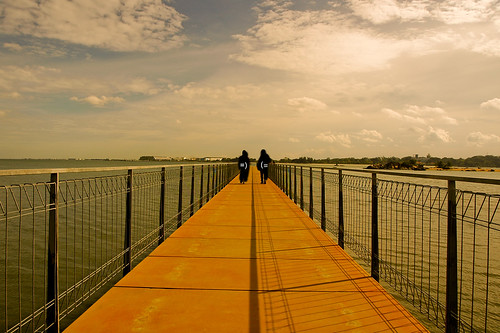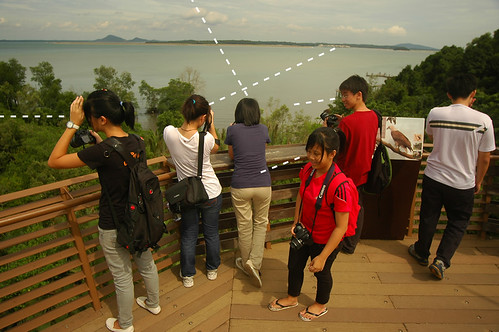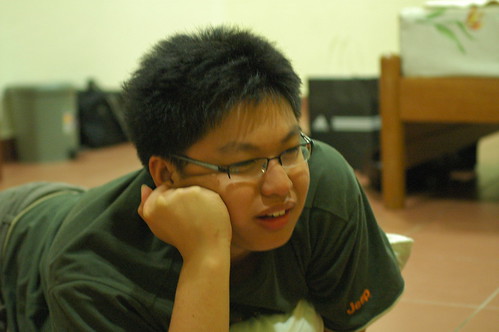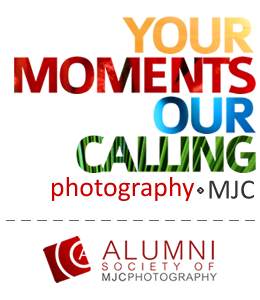Friday, January 30, 2009
Changi Boardwalk
Tuesday, January 27, 2009
Equipment equipment equipment...
2007 was the year when I decided to start building up the club's inventory. 2007 was also the year that I officially took over from Mr Tee as the Teacher-in-charge (even though I already came in from Oct 2006 for the inaugural Prom Nite Print n Sell which eventually morphed into the Prom Nite Glamour Shoot).
At that time, the club had only 3 Nikon DSLR (2 x D100 and 1 x D70) and quite a number of lenses (1 x Nikon 24-105 VR, 1 x Sigma 70-200 f2.8, 3 x Tamron 24-135, 2 x Sigma 50 f2.8 macro, 3 x Sigma 15-30) and enough external flash heads. In our possession also included about ~ 10 prosumers (Fujifilm S602 and Minolta Dimage A1). Imagine, Minolta became Konica Minolta and finally Sony... such was the length of progress... For posterity sake, please remember that cameras were much more expensive in 2003. The S602 cost the equivalent of a 400D and the A1, a 40D.
Though I believe in the mantra that the photographer is the more important than the equipment used. But to swing to the extreme and discount the equipment is also a load of bull. I witnessed for myself the 2005/2006 batch (Benjamin & Junsen's batch) using the prosumers and end up having blurred and noisy shots. For an aspiring photographers, these photos could be rather discouraging. Only a few privilege ones could use the Nikons and they are normally the exco members. For Benjamin's batch, the D70 wasn't available till 2006.
Though there have countless examples, out on the internet, of beautiful photos taken using the prosumers but most of these photograpers were rather experience and they have the knowledge to work within the limitations. However not so for students. If I don't even remember wrongly, they were not allowed to borrow the cameras for personally use (with the exception of Junsen for his China trip).
The limitations of the prosumers were many...
1. Shutter lag
2. Focusing speed
3. ISO noise control
4. Limited focal length of the built in lenses
5. Inherent wide depth-of-field due to the small sensors
Now the 2006/2007 batch (Kingston's batch) was much smaller than Benjamin's. From 30 plus to 10 members. Therefore Kingston's batch was able to have much more opportunity with the DSLRs. Trust me, using the DSLR for the very first time can be quite intriguing especially if you have been using a compact for some time. The depth-of-field control, focusing speed and ISO noise control is so so so liberating.
Therefore when I took over the club, I knew that if I want to attract more students and give them more opportunities to take photos which they would not be able to achieve with their compacts, I need to grow the club's inventory. For 2007, a lot hinged upon the budget that would be allocated to Photography. The 2006 budget was paltry, not even enough to buy 1 camera body. However I was fortunate that the 2007 budget was 6x bigger. But though the budget was much bigger, I was only at most able to purchase 2 x EOS 350D with a complete range of EF-S lenses to cover 18 - 200 mm. Hmmm... why did I mention Canon??? Should I be talking about Nikon since the school was using Nikon then.
At the end of 2006, I was at a crossroad. I wanted to grow the club's inventory but though the 2007 budget was 6x bigger, I was only able to purchase 2 cameras with lenses to cover 28 - 300 mm (35mm equivalent) after setting aside money for the club's consumables (mainly ink and paper).
Sounds impressive huh??? The cameras will have to be D70s and the lenses are the consumers type. Basically entry level systems and frankly speaking they are good enough for beginners. However Nikon cameras then were quite poor when it comes to ISO performance. Anything above 800 will be very noisy. Even Mr Tee's D2X was noisy at 800 and that's why he uses his D2Hs for low light events as it is a 4 MP cam (very large photosites) but still D2Hs was considered noisier than Canon's entry level 350D. So I was considering whether to switch the club to Canon.
Now that's a very big decision. Switching to Canon would mean that I have to rebuild the inventory from scratch as Nikon mount lenses are not compatible with Canon's and vice versa.
Reasons to switch:
1. I am a Canon user and often I find it difficult to guide the students in operating the camera (there's a difference between photography techniques and operation of camera) when shooting as I'm unfamiliar with the interface.
2. Canon cameras have better ISO performance (it was true till the arrival of Nikon D300, D700 and D3, which kinda balance out the ISO issue).
3. Canon equipment are on par in terms of costing when bought new but they are cheaper if bought off the 2nd hand market thus giving better bang for buck.
4. I can loan my equipment to the students if the need arises.
Reasons not to switch:
1. Students who were using Nikon may find it difficult to adapt.
2. The basic equipment were all there and I could start buying more specialized lenses like ultra-wide angle, fisheye lenses etc.
3. Canon system would have to rebuild from scratch.
So the decision to switch was a difficult one.
Also I was very mindful of the feelings of certain people:
1. Mr Tee. After he is the venerable photographer of MJC and he started the club from scratch.
2. Kingston's batch of members. They have grown used to the Nikon system and they are Nikon 'loyalists'.
I spoke to Mr Tee to seek his opinion and he was very gracious. He said, "Since you are in charge now, you have the authority to decide. Furthermore you are familiar with Canon and it would be easier to guide the students.
Now the real headache was with Kingston, Eunice and Chee Howe... When I sounded them out, they were howling with disapproval. They even made sure that I knew of their disapproval over MSN.
(Just to let you guys know how difficult it was. I almost decided to stick to Nikon and actually placed an order for the Nikon 18-200 VR lens)
In the end what tipped the balance in favor of Canon was the 2nd hand market. I was initially under the impression that I would be able to purchase 2nd hand items as it would pose certain administration headaches, but after speaking to the finance manager, I realized that it was possible. (the 2nd hand market, till now as of time of posting, gives much better bang for bucks when it comes to Canon equipment as Canon was ahead of the competition)
Hmmm... did Kingston and co. agree??? Well... they didn't exactly but since I'm boss, they had to 'comply'. However I'm sure they knew that I had considered seriously their views then.
So in Dec 2006, I made my first round of purchases. I bought 2 x EOS 350D with accompanying EF-S 18-55 lenses. I also got a Sigma 70-200 f2.8 that comes with a 2 x teleconvertor and a Canon 10-22 ultrawide angle lens.
Somewhere in March 2007, Chee Howe approach me with this idea to raise funds for the club by taking over the passport size photo taking of the JC1 students. Actually I already had the idea in mind but I didn't approach them because the exco was small and they were already up to their neck with the projects and school work. But still kudos to Chee Howe for being so 'enterprising' and taking the initiative. That's what I call ownership. So since its student initiated, I agreed to it. For this project I procured 2 x 300w Jinbei studio strobes and accompanying softboxes. (Anyway this project is another story in itself).
The procurement of the studio strobes were also part of a larger plan I had in mind for the prom nite. But having studio strobes will not be as useful if I do not have studio backdrop and stands. Ha... the issue of purchasing the backdrop and stands was another 'titantic' struggle between me and Kingston and co. But even eventually these purchases were integral in expanding the club's expertise and the members had tremendous amount of fun and greatly accelerated their learning. To know more, refer to
photography > MJC: Studio Days
photography > MJC: Just Some Thoughts Part II
The passport size photo project was a success and raised a substantial amount and I was able to procure another 2 x EOS 350D with EF-S 18-55 lenses and another Sigma 70-200 f2.8 that comes with a 2 x teleconvertor and a 430 EX Speedlight (external flash).
Though Kingston and co initially complained about issues such as the build quality, small handgrip, seemingly inferior user interface but I'm sure they enjoyed the better ISO performance and the ultrawide 10-22. I still remember Eunice quipping about the distorted perspective which resulted in an ultra long female arm when she covered the Science Fiesta's Egg drop competition.
Eunice was also the 1st one (I think) that I allowed to handle my 70-200 f2.8 L IS lens. At that time, she was my most trusted photographer.
So the 2007/2008 (Quentin's batch) was the first to start off their photography journey using the DLSRs. I banned them from using the prosumers.
Personally I can see that my strategy was paying off. More of the JC1s were participating in shooting school events. More members were also keen on exploring photography on their own. I also allowed students to borrow the cameras home though the possibility of having them damaging the equipment is there. Bit by bit the proficiency level increased.
In Jan 2008, still I felt that we could do with more camera bodies and at that time, the used price of the 20D has dropped thus I procured 2 of them. The 20D was a semipro DSLR and it was also my first DSLR. It was really a joy to use it. The multi-controller and the big rear dial really helped in speeding up the handling. Suerya said that the 20D rocks when she first used it. In March 08, I bought 4 EF-S 18-55 with IS function and a Lensbaby 2.0 when I was holidaying in Hong Kong. The new EF-S lenses were for the 20D cams and to replace some of the older non IS versions. IS is very useful as it can compensate for handshake, giving up to 3-4 stops of advantage. The Lensbaby was for creative purposes as it give selective focus due to the flexible tubing.
Somewhere in April 2007, I bought either 3 or 4 EF-S 55-250 mm IS lenses. These were to complement the EF-S 18-55 lenses. Finally all the 6 EOS cameras have at least a range of 18-200 mm (35 mm equivalent of 28-320 mm). However I'm still short of external flash heads.
2008 was also the year which the new prices of entry cameras such as 400D and 450D were so low that you can easily purchase them with a budget of slightly more than a thousand dollars. The 2nd prices were even much lower. So some of members of the 2008/2009 batch (Elliot's batch) were able to buy their own cameras. Therefore ... (haven't finished but post to satisfy initial pangs of cravings)
(Now resuming the 2nd part of the 2nd part)...
Therefore, it kind of give me the flexibility to move away from just accumulating camera bodies.
Oh I also remembered that somewhere late 2007, we had our newest computer, a Dell Quad Core. Some of the reasons why we needed a new comp was because the 2 Power G5 were showing their age. With the amount of processing we are doing, a blazingly fast computer will definitely serve us well. Furthermore we will have to cough up more money if we get another mac as we will need to purchase a newer version of Photoshop etc... Anyway the Dell was so fast that Quentin was gleefully showing off how it could open a hundred files in CS2. So the Dell has been our mainstay for the past 1 year plus. However as with al Wintel platform, some form of instability is settling into the Dell. Recently Shirleen was showing me how CS2 would shut down when she was editing the text. Trust me, I have never seen CS2 shutting down so fast. In a blink of an eye, it was gone with all your processing efforts. Hence for 2009, I've issued a challenge to the Elliot and co. to raise funds for a new Mac Pro.
Coming back to cameras and lenses, I purchased the first Canon primes early 2008. They were the 50mm f1.4, 85mm f1.8 amd the 100mm f2.8 macro. The kids had a lot of fun with it. They took portraits, macro, still life and etc... Something that wasn't really possible with all the zooms we had (with the except of the f-mount sigma primes).
The rest of the funds were mainly used to purchase more printing media. The year 2008 saw a 2 - 3 fold increase in printing output. We also spent a lot on mounting boards. 2008 can also be reckoned as the year of exhibitions. We had exhibitions after exhibitions and Quentin and co. is always coming back to me, "Mr Cheng, we need more mounting boards."
In Nov 2008, I purchased another set of lights, this time round I bought branded ones, Elinchrom. This was in preparation for 2008 Prom Nite. We set up 2 shooting stations so that we could clear the queue faster. We spent a bit of money on promotion by means of photo frames to show out the larger prints. Honestly it wasn't just for bigger margins that I pushed for larger prints to be sold. Somehow larger prints command more visual attention and it would be a pity if the prom niters leave with a 4R print of them decked out in finery.
The 2008 Prom Nite Glamor Shoot was an all time success. Needless to say, we made a tidy amount but the money was quickly used to purchase more printing media and equipment. Often I try to fulfil the wishes of the members but once again, money is never enough. However I did managed to get another 85mm f1.8, 50mm f1.8, 200mm f2.8 L, Manfrotto tripod and a set of Tianya filters + 77mm ring adapter (just nice for the EFS 10-22mm).
Finally I'm back to the first point about getting better equipment instead of more equipment. In Jan 2009, I purchased a used 5D and a 24-70L f2.8 L. I'm also holding on to a 1D Mk2 which I will loan out to the students for use. Basically we will have different cameras for different purposes. However due to increasing wear n tear of equipment (possibly due to negligent), I've decided to be stricter with the usage of the 'pro' equipment. I hope my students can understand the rationale. Recently we had to repair the 50mm f,14 and it costs us $250. I've also repaired 2 350D and 1 20D. I still have 2 EFS 18-55mm kit lens which are damaged and I will most probably leave them unrepaired as its most probably cheaper to buy them second hand than to repair.
But at the end of the day, the equipment serves the photographer and not the other way round. So carry on making the image of your vision.
PPC.
Monday, January 26, 2009
Thought you might be interested..^^
I bet some of you all would wonder what a wedding shoot is like and what kind of pictures the clients get... Well then, since it was uploaded online... (not by me of cos..) you might wanna take a look.. (Well, its not really my cup of tea cos its kinda mushy and etc etc etc...) Enjoy
Eric & Grace Solemnization from lighthousephoto on Vimeo.
Ohh.. in case you wanted to ask, I took abt half the photos.. so u can guess which are mine.. hahaha... But I did the DI work for all the pics..
Friday, January 23, 2009
Preamble to a Dissertation - I
Wednesday, January 21, 2009
Love Matters
It was quite an interesting exposure for me. I'm not inexperienced in shooting. I'm not inexperienced in covering events. Neither am I inexperienced in asking people for a photo. What's interesting in this event was that I was shooting local celebs, and the intimidating photographers around make everything all the more scary.
What made the event easy for me, was the presence of the da ge da jie photographers. They are very experienced in shooting such stuff, and I think the shooting part comes very easily to them. For me, I'm still very new to covering such a type of event, hence I had to ride on every opportunity there was. I have to admit I was shy. I feel like J1 all over again. (But then again, I don't remember myself being a shy photographer back in J1.)
However, the celebs were very intuitive too. They would pose for every photographer who was there, and each photog would have their turn with the celebs. All I had to do was the Finger. Haha, don't think about it in the wrong way. Just the simple act of putting up one index finger, the celebs would pose for you, and if there is the luxury of time, you can ask them to pose in any way you would like them to.
Ever since I joined Nanyang Chronicles, there was no form of tutelage and photographers have to just go out accompanying their writers and shoot. Shooting for a paper is almost a wisdom of its own, kinda different from the event photography I was very used to. (You just imagine when you are a green J1 photog who got some tua tua liap event and your senior never help you...)
Nevermind, let me share some pics, but I wont be posting any of those that I submitted to the Chronicles until they are published. Maybe by then, I wouldn't have bothered... =P
Oh, I did manage to shake Yanyan's hand. You know, the papaya sister from 881. She seems to be a very nice and friendly person.
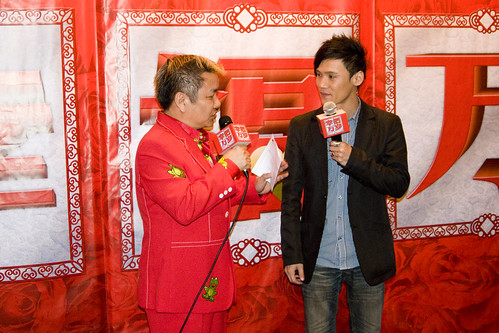
This guy looks really familiar. PPC, is he the one?
He sang the theme song for Love Matters.
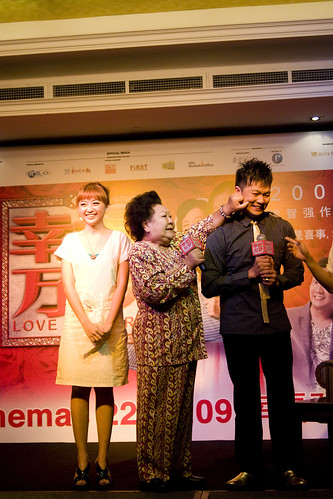
The young ones are Malaysian DJs who stars in the movie, alongside with our very adorable ah ma...
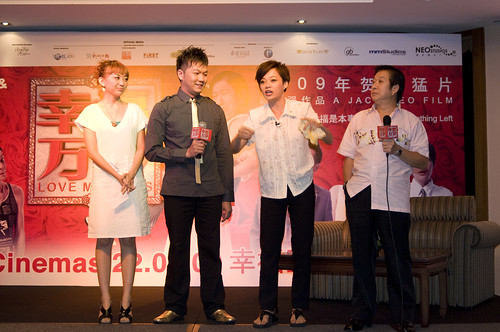
Tuesday, January 20, 2009
Learning to See - Finding One's Vision
Jun sen had mentioned in his uber long post, there is always things around us waiting to be shot. They are all there eagerly waving at us, wanting to be shot. However its up to us to find them and shoot them. So don't ever mention that there is nothing to shoot when u are out with a camera.
Okay enough of me, lets listen to the "wise man". Heres the article :
--------------------------------------------------------------------
Vision, Not Technology
Possibly the biggest curse of the digital photography revolution is that it has excessively focused photographer's attention on technology, rather than vision. We now have tools that allow us to take very sharp pictures indeed, but a sharp photograph of a fuzzy concept is of little interest or value to anyone.
Why then do the majority of photographers, magazines and enthusiast web sites concentrate almost exclusively on gear, secondarily on technique, and hardly at all on how to see? The answer is simple – it's easier.
I can explain, for example, how depth of field works. If I'm a good teacher you can learn about this aspect of photography fairly easily, and then quickly put that knowledge into practice in your own work. If how best to use a certain tool in Photoshop is what you're looking for, then the numerous tutorials on this site will be found useful. And, if you're like some 85% of visitors to this site, you'll likely first turn to the equipment reviews.
Why? Because – in order;
– an understanding of basic photographic technique must precede any form of competence
– utilizing contemporary tools is one of the cornerstones of the digital zeitgeist
– the belief persists that good equipment helps photographers take good photographs
Of course it is the later partial fallacy that trips most people up. The pitfall being the use of the word "good". Of course the best cameras and lenses can produce images of superior technical quality to gear that is less capable. Similarly, having an understanding of the photographic basics is a prerequisite for anyone who wishes to master their craft. And, unless one wants to learn the tools and techniques of the traditional darkroom, learning Photoshop has to be high on most photographer's to-do lists.
But, a good photograph isn't measured in line pairs per millimeter, MTF functions, S/N calculations, or any of the other measurements that photography enthusiasts recite like religious mantras. The most important tools that are used to take good photographs are the human eye, the human brain, and the human heart.

Grandma and Chair. Paris, France. September, 2004
Canon 20D with 17-85mm IS Lens. ISO 400
____________________________________________________________________________________
By The Numbers
If you're a regular visitor to this site you will have noticed that when I publish my photographs I almost always provide a line of technical data; camera and lens used as well as ISO setting. Very occasionally I will provide some additional nitty gritty shooting data, typically if the photograph is being used to illustrate a technical point being made.
As to why I publish the camera and lens information – the answer is, because when I don't I am inundated with e-mails from readers wanting to know which camera did I use, and with what lens. Does knowing this information contribute to an esthetic appreciation of the photograph? Likely not. When was the last time you saw a photographic exhibit where the type of equipment used to create the photographs was known? Likely never, because fine-art photographers as a rule want to pretend that their art is divorced from the crass realities of craft and technology.
But the insecure, the newcomer, and the inexperienced believe that the ability to take visually interesting and compelling images comes from equipment and technique, while in fact, though these are necessary, are secondary at best to the need to also learn how to see.
____________________________________________________________________________________
Finding Your Vision
Unfortunately, learning how to see is as difficult as it is to teach. If learning it were easier the young man who wrote me the above letter wouldn't have felt as adrift as he does in a sea of technobabble, digicam reviews, and B&H advertisements. If knowing how to teach it were easier, I, along with other photographic educators, would be doing a better job at fulfilling our mission.
So, you say, it isn't easy to learn, and it isn't easy to teach; what do we do then?
Here, as best I can using the printed (transilluminated?) page, are some suggestions for setting off down a path toward learning how to see; how to develop your own vision. Unlike leaning a new Photoshop plug-in, this isn't something to be mastered overnight, nor likely even in a lifetime. In fact there is no goal; no destination. To the extent that there even is one, the journey itself is the destination. For the person who wants to learn how to really see photographically, photography itself has to become a way of life, a passion, a calling. If you want to find yourself traveling this path, then here are some suggested routes to follow.
____________________________________________________________________________________

Mime. Paris, September 2004
Canon 20D with 17-85mm IS Lens. ISO 400
---------------------------------------------------------------------------------------------Looking at Photographs
Here's the first step: start looking at photographs. Visit a good book store and look for images by photographers whom you admire. Buy a few books, and spend some considerable time studying them. Not with the TV on in the background, but by yourself, quietly, and at some length. Look at each image, and ask yourself what it is that captures your eye. Is it the light, the subject, the composition, a combination of these, or something else?
If you can, look at a range of one particular photographer's work, ideally covering a long period of time. What themes, if any, can you identify? Do you see a progression of style, or an evolution? Did that particular photographer's work improve as his or her career progressed, or was their best work done early?
If you live in a large city, or the next time that you visit one, visit a couple of photography galleries. Look at the work that your contemporaries are doing. Do you find inspiration or despair when you see the work of others?
Looking at Art
Photography is the youngest of the visual arts. Visit an art museum and look at both contemporary as well as historical paintings, watercolours and lithographs. What styles and periods do you like? Which artist's work excites you? You don't need to have a formal art background, or even much knowledge or appreciation for painting. But, when you look at how visual artists have recorded and interpreted their worlds over the centuries, you may derive some insights into your own way of seeing things, or even discover a new way of doing so.
Attending a Workshop
One of the most popular methods for photographers to improve their craft is to attend a field workshop. Usually lasting from a long-weekend through a week or ten days, working together with a small group of like minded photographers in an interesting location can be creatively stimulating. And, of course, if the workshop leader is someone whose work you admire, and they have some skill as a teacher, working alongside them can be very stimulating as well.
If you can though, try and join a workshop or seminar whose purpose is to explore creativity, and to provide critical feedback. Few people have an opportunity to have their work critiqued by someone with a discerning eye. "That's a nice shot..." just isn't the type of feedback that helps anyone learn and grow. The more critical the evaluation of your portfolio, the more valuable it will be to you.
Taking Photographs
Of course, the eye is like a muscle. It needs to be exercised. Musicians know that unless they practice daily, they'll loose their edge, and it's no different for photographers. The best way to learn how to see, is to practice seeing. And, since with the advent of digital the cost of turning seeing into images has effectively been reduced to zero, the only excuse for not spending time each day shooting is ones other time commitments.
But even the busiest person can steal a half hour at lunch time, an hour in the evening or before work, and certainly a few hours on weekends. It doesn't matter where one goes, or what one shoots. The idea is to have a camera in hand and force yourself to record images. Then, at night, load them onto your computer and see what you've recorded. Even if it's just a shot of your back yard furniture, or the dog next door, ask yourself why you shot it the way you did. Then tomorrow, try to see it differently and shoot it again.
No need to save these files. Just trash them after you've spent some time examining them. Don't even bother doing any post processing. Just shoot JPGs, and set your camera on automatic. The issue here is not technical perfection, or aspects of image quality. What you're trying to do is break way from the mold of concern over equipment and technique. You want to divorce yourself from everything except the question of seeing, and recording what you see in a way that's meaningful to you. (If, after a while of doing this, you're still worried about chromatic aberration on your lens, consider taking up another hobby).
Gutter. Paris, September 2004Canon 20D with 17-85mm IS Lens. ISO 200
Don't Fear Taking Bad Photographs
That's why I suggest shooting digital and throwing the files away when you're done. A musician doesn't record every performance, and artists are constantly making rough sketches. Shoot freely. Explore the world around you. See how something that you saw and shot yesterday can be different today, in different light or weather. Or, maybe simply because of your mood. Don't show these to anyone. Don't save them. Feel the freedom to take photographs and then destroy them, with only your memory as a record. Sometimes, as with the case of the gutter reflection on a Paris street seen above, something unexpected happens, and the exercise might just become a performance worth recording.
Then, when you do find yourself out taking photographs in a place where there is potential, you may just find that two things will happen. You will be more open to possibilities, and your fluidity with your equipment will be enhanced.
If u ppl want the URL its here:
http://www.luminous-landscape.com/essays/learning-to-see.shtml
Okay see ya & happy shooting :)
Monday, January 19, 2009
Iconic Singapore Photo competition
Sunday, January 18, 2009
Saturday, January 17, 2009
The more I think about it, the more I'm worried...

Friday, January 16, 2009
Wednesday, January 14, 2009
The World Is Just Awesome

The World Is Just Awesome.
By Ng Jun Sen
These days, students aren't having it good. Stress levels have reached stratospheric levels, and if you place all their homework on an aircraft carrier, it would most certainly sink. It's really not hard to understand why your nearest shrink has a thicker wallet despite the credit crisis.
The government knows this, and in the recent years set in motion great plans to overhaul the entire education system. You see that going on with the change in the syllabus, an upheaval in every subject taught in schools and colleges, and an emphasis on both the humanities and sciences.
So now, youths receive what our good ol' government says is a "more focused and all-rounded curriculum", but I've thought about that, and realized it's just like saying you take pride in being a chauvinistic male, hate girls, but would like to undergo a sex change operation.
Sadly, the men at the bureau of the Red Bolt and Blue Ring do not really understand that the crux of the problem isn't what students are studying nowadays, nor is it the methods to learn the curriculum, but the tremendously high standards set by the primitive fear of losing out.
I know this because I have taken up tutoring English at a neighbouring tuition centre, and even the Lower Secondary books it provides showcase sesquipedalian and superfluous words like "sesquipedalian" and "superfluous". I could sympathize with the browbeaten sods who decided to pay for my amateurish lessons after torching their hair in frustration, knowing that the longest word they ever put down in Scrabble was "banana" and that only gave them 7 points. Not enough when clever little Mary across the table spelt "gubernatorial" across two triple-word scores.
The nail in my foot with local education in general isn't any of the above, but it is the bare fact that it spares none of its affectation as a tool in the intellectual factory on the creative arts, and instead strives for unnecessary streaming and categorization of our ambitions. You couldn't choose to be a business professional and a DNA aficionado at the same time because the universities would laugh their heads off at your course selection, and there goes your future as a filthy rich CEO of a cloning company.
And because I know the people who are reading this now are either students or internet stalkers or lost souls who googled "MJC Prom Photos" and ended up here, I also know you'll agree with me about the state of our education scene. It isn't pretty, but you're stuck with it and over the years of repetitive studying you realize that all your complaints and wrist-cutting isn't going to change the reality of a Singaporean childhood, so you accept it. And with time, you forget that you ever had opinions like that.
I was frustrated with these limitations accorded by local education, so for most of my youth I screamed and shouted a lot, of course only if I'm isolated and unseen by the public. But it seems that I'm not alone in this. Jack Neo, who happens to be my neighbour, appeared to agree with me after hearing the melange of rants I gave to the friendly face in my bathroom mirror, and went on to create several local films criticising the education scene.
Not surprisingly, the local media got all overwhelmed and fan-girly that there's finally a Singaporean film which wasn't shot by few drunken dudes with camcorders, so they ate it all up and gave the films a thumbs-up, lauding Jack Neo's brain and brawn at taking on a taboo topic even though Big Brother is watching. People everywhere patted each other in the back, congratulating each other on the progress of Singapore's entertainment scene.
So as it is with all successful local movies, it was heralded as a milestone in our film industry, the company made a lot of money, the director earned mentions and accolades in PM rallies and then people quickly forgot about it because the next Harry Potter film came out.
It makes me wonder that when an issue is revealed for the first time, everyone will begin thinking that it is the most important thing of all. But then, with time, people move on, leaving the issue unresolved.
It's all like the news, really. You read all about Mas Selemat in what seems like years ago, and whatever happened to him now? For all you know, he could have boarded a ship and headed out towards the calm of international waters, only to end up looking down the barrel of a rifle held by a Somalian pirate.
And as the pirates demanded for ransom for the ship and its motley crewmembers, news agencies swooped on this breaking news story and sent their journalists down to sweltering Africa for this mission.
But then the credit crunch and U.S. presidential election came along and stole all the attention from the guys with the notepads, so they flew to America to conduct talks and interviews with fat economists, stupid bankers and Joe the Plumber.
No one cared about Mas Selamat and the rifle-totting Somalian pirates anymore. They had their time in the spotlight.
This doesn't really bring me to the Alfa Romeo Brera, but does, in a way, as you'll see later. Under the bonnet of the Brera lies the sprawling mass of a 3.2L V6 engine, producing just about 256bhp, which really isn't that big of a deal nowadays. The weight of the car, however, drains all those horsepower away. At 1600 kg, it might as well weigh as much as a small galaxy, or Oprah Winfrey, or both.
As a result, it takes seven seconds to reach 60 mph and four days to reach 100. It has about 321Nm of torque, enough to shuttle you to the grocery store and back. Unfortunately though, you only have enough boot space to put a grand total of two potatoes and a carrot, because the designer decided to taper the arse of the car. So you have to make multiple trips, only to find that you lose 12 litres of petrol every 100 kilometres.
A friend of mine has the Alfa Romeo, the one with a downmarket 2.2L JTS power station and a manual gearbox, and because of that it makes everything even worse.
I had the privilege of riding in it the other day, and frankly I wasn't expecting much, having looked at the specifications. There's such a huge selection of sport coupés out there, so why not the new Audi TT which I know is a technological marvel, the punk-styled Nissan 350Z, the venerable Mazda RX-8 or the fantastic little Honda S2000?
I got my answer when I approached the car, and it was such a feast for the eyes. The front has been styled to look like the nose of a fighter jet, the profile is so ingeniously designed to be as slippery as possible through the wind, and the staggeringly beautiful six front headlamps tells the world that the Alfa has arrived.
And my breath was taken away the moment I saw the interior. To create the leather seats of the Alfa, six cows had to be sacrificed. The dashboard had sporty dials and gauges, but they weren't as crude and obnoxious as the ones you find in a Mitsubishi or Subaru rally car. Even watching the windscreen wipers move was like bearing witness to the baton of Herbert von Karajan conducting Rossini's William Tell Overture, and you're in the front seat.
This wasn't a feral hound like the Mazda, or a science lab like the Audi. This was a refined, gentleman's car, and because it is from Italy, it has the passion and soul that has stuck on with the Alfa Romeo moniker over the years. The Brera isn't a car. It is a work of art.
But as I was driven around by my friend, I got the sense that he lost the point of it all. As a motorhead like me, he complained about the same things I mentioned above, that the seats were too hard and that being a front wheel drive, there was far too much understeer. The JTS engine up front resembled a dying mule pulling a chariot, way inferior to the top-of-the-line V6, and the noise it creates is as exciting as the cacophony of wheezes in an asthma ward. Worse were the little gadgets here and there that kept breaking down, such as the driver seat recliner mechanism and the squeaky hinges on my glove compartment.
Why then, did he decide to buy the Alfa? Surely he had heard of Alfa's infamous reputation for frequently throwing an Italiano temper by refusing to work, and only relent when you're just about to give up on it. Isn't it a universal fact that anything built in Italy could only be reliable if there was Parmesan cheese spread over the top or a Ferrari badge emblazoned out front? Look at Silvio Berlusconi, the slit-eyed Prime Minister of Italy, who had recently explained that his support for Barack Obama was due to, for no better reason, his suntan. Not a very reliable person you want to head a country, is he?
I'll tell you why, and the reason is the same as why Mr Berlusconi can carry out his antics and yet keep his job. It is because of these quirks that the Brera distinguishes itself from its competition. It has a character, a fiery and passionate one, unlike that which you get from an Audi, which because it is made in Germany, does an exceedingly good job in never failing on you to the point that it gets boring.
But the Alfa is never boring. It has the sort of exterior that makes you turn around after you've parked it for the night and take a second look at it again, admiring it as if you are a parent with a mischievous and hyperactive child who has just fallen asleep in your arms.
That is why people buy Alfa Romeos in the first place. You don't think about what it is like to live with the Brera, but the fact that you fell in love the moment you set your eyes on it. You trace the sleek curves and lines that bear down the chassis of the car, only to break away to form a corner; the triangular trademark nose, topped with the escutcheon of Alfa Romeo -- fearsome yet refined. It seduces you and fills you with the raging onset of an amatory affection; you just have to own one.
Perhaps my friend forgot what it felt like to look at the Brera for the first time, because it's been three years and all he remembers now is the many visits to his osteopathic physician as a result of the seats. It's like purposely forgetting how it felt to fall in love and go on dates with someone because your phone bills were rising. You lose your bearings on what really matters.
And I think you know by now that the point of this lengthy lamentation and candour is precisely that. People forget these important nuggets of opinion, and it's because they've lost the drive to keep remembering, or because time does these things to our grey matter. In so doing, we lose a part of our soul, our definition, and most saddening of all, our appreciation.
Which finally brings me on to the topic of photography.
No, wait, actually, it brings me back to the year 1904 and a man known as Edward Steichen, who lived in a nice house in New York.
Born in Luxembourg in 1879, Steichen was a painter by profession. In 1881, his family moved to America, and he naturally followed, becoming a citizen in 1900. As he grew up, Steichen fooled around with paint and brushes, gradually establishing his name as a fine art painter.
But during one point in his life, Steichen must have gotten quite bored with having to wash oil colours from under his fingernails, because he began to take photos instead.
Back in those days, they didn't have silly SLRs or microchips to sense light. They didn't even have film. What they had were plates of silver halide manually inserted behind a ground glass, with a lens to focus the light on it. There was no automatic film winding, no auto-focusing; there wasn't even a meter.
Furthermore, because the film plate was so large, it meant that the camera built around the damn thing had to be quite gigantic. Since Nikon and Canon were still a bunch of atoms in their mother's womb, the sort of camera that Steichen used was made of wood, and was therefore as heavy as the Moon. As a result, you needed to carry around a tripod, and because back then aluminium was the kind of thing you found in rocks instead of MacBooks, that was also quite heavy too.
That would all be fine if you had a Brera to drive it around, but in 1904, that was the name of your Clydesdale horse, and you couldn't trust it because it had no independent suspension or anti-roll bars, so your camera would fall off and become what can only be described as pieces. If you wanted to go on a hike with your camera, you had to carry it yourself, or call up the local slave agency and employ a bunch of people to do it for you.
And I know Edward Steichen had no slaves because Wikipedia said no such thing. So in 1904, he carried his camera and tripod and plates of film into a damp forest in Mamaroneck, New York in the middle of the night all by himself. He came back with this.
Titled "The Pond --- Moonlight", it is a stunning colour photograph in the style of the Pictorialism era, and is one of the greatest classic photographs ever taken. It is phenomenal, and every time I am haunted by the impression it leaves. There are really no words to describe images like these. Imagine a large 40" print of this on your living room wall. My god.
The best thing of all is, someone did, and willingly paid US$2.9 million to make himself very happy, sealing its place in the record books for being the second most expensive photograph ever sold.
Now, if you analyse Steichen's mentality at that time, he wouldn't have gone all the way into a dark and ominous Mamaroneck forest in the dead hours of the night to come home with nothing. He risked getting lost in the horripilating cold, getting mugged by thieves or getting bitten by mosquitoes and vampires. Back then Edward Cullen wasn't as friendly.
So the last thing you would hear from Steichen, really, is that there's "nothing to shoot", as that would mean that he wasn't worth a Wikipedia entry.
The thing is, I hear that quite often nowadays, for some reason, and I think it may be due to the conveniences of technology, and I'm referring to the Nikons, the Canons, the Gitzos, Benros, Manfrottos and the lot.
But I'm not going to be iconoclastic and start criticizing technology, because I actually believe that it is a symbol for Man's triumph as the paragon of animals. What we should change, is not our equipment, but our mentality.
Photography opens our eyes to the world. Do you remember the first time you held a camera, and you promised yourself that you would take powerful and breathtaking photos? As you walked down the cobblestone street with your hands gripping the camera, you began to look around you with those eyes of beatific wonder, as if a new world has surfaced and you're there to capture it? Isn't it awesome?
But gradually, as you head down the spiral of technical knowledge, by learning more about photography or acquiring newer and better equipment, you begin to lose that sense of wonder, almost as if it was inevitable. There's no reason why, but you just do.
So when you find yourself on a stunningly beautiful offshore island like Pulau Ubin with a top range DSLR, you start to drag your sodden feet around and make a sudden realization. You start to say that there is really "nothing to shoot around here".
How could that be?
People close to me would realize that I watch plenty of Discovery Channel. I am a diehard fan of Mythbusters, Time Warp, Dirty Jobs with Mike Rowe, The Long Way Down and other documentary programmes from there. There're few things that can replace the feeling of coming home from work all enervated and spent, and then plonking down on the living room couch to watch Adam Savage and Jamie Hyneman test a myth by blowing stuff up. Hugely entertaining.
But during the advertisements, Discovery Channel will always play a clip to remind its audience of their slogan, "The World Is Just Awesome."
That, in my opinion, is a fantastic phrase, and it's really why I love photography, and why I stop at nothing to take great photos. Whenever I begin to forget the reason why I label myself as a photographer, or whenever my brain gets a little bit weary from photography and start to lose the drive to continue, I'll repeat that mantra to myself.
And I think it'll do you good too.
There's always something to take a photo of, and it's all around you. All it takes for you to do is to realize it's there, and then you let your technical self take over. That's the real difficulty of photography, and the precise thing that many of us as photographers of many years are suffering from now. It is such a mental exercise.
But tell yourself that the environment around you is a boundless cradle of photo opportunities, and carry on shooting; that the world that we live in is an awesome show of beauty and grace, and you have to capture it; that life is filled with limitless stories, and as a photographer you are the ambassador of information and you wield the medium of truth.
Because the world is just awesome, and you're where you should be to photograph it.
Don't ever forget that.












(and as requested by Quentin for the portal)
Ng Jun Sen is an award-winning photographer who has been taking photos for almost ten years. He is due to start his university education in the Faculty of Arts and Social Sciences in the National University of Singapore.
Unfortunately though, he's a little bit insane, so approach him with caution. Despite his experience in photography, he has never been published and still remains quite bitter about it. He maintains that photography is too expensive for him, and his greatest ambition is to "succeed in life."
For some strange reason, Jun Sen is now the Vice-President of Photography in the Alumni, playing his part in photography education and training.
Apple one day sale
Tuesday, January 13, 2009
Monday, January 12, 2009
Sunday, January 11, 2009
SPCA Studio Shots...

Friday, January 9, 2009
Announcement
HELLO PEOPLEEEEEE!
FOR THOSE WHO'VE BORROWED EQUIPMENT FOR UBIN/MISC/WHATEVER....
PLEASE RETURN THEM ASAP WHEN SCH REOPENS.
(ALMOST EVERYDAY AFT SCH)
THANK YOU FOR YOUR COOPERATION :D
QM 08/09
ANGELINEEEEEEEE.
Thursday, January 8, 2009
My First Semester in NTU
Like all other educational institutions you have went through so far (a.k.a primary, secondary school and JC), there's a lot of initiative you will need to make your study period an enjoyable one. Firstly, making friends. If you hate Orientation, and you despise the fact that you have to attend... don't worry, it's not compulsory. I didn't attend FOC and in my first week of school, I was pretty clueless and walk into class gong gong, as if I didn't know anything at all. In fact, as a Communication student, I really have no idea what's going on- because my course of study is so different from what we were used to in school last time, there wasn't the science nor the humanities. Ok, then I only knew one girl who was from my previous work place, and saw a few familiar faces from MJC, but I didn't say hi. I'm kinda a bit anti-social... ha ha ha... But I admit it la, despite my unamiable face, I did make a few friends who are very helpful and will always nag at me when I'm late for class. =P
The most tensed period of uni life would of course be the start and the end of the term. During the first two weeks, we have something called an "add-drop period". That's the NTU system for registering for electives. We get to register whatever we wanna study, it can be econs, psychology, sociology, engineering (YUCKS!), maths, arts, blah blah blah. In order to graduate, we have to fulfill a certain number of General Electives, Prescribed Electives and Unrestricted Electives. That's not the irritating part, because the math would already be done by your school and you just register according to the type of electives you have to fulfill for this year.
The irritating part is, each course has already its prescribed time slots, and hence this irritates the _______ (fill in the blank) out of me. Your favourite electives either clash with your core's timetable, clash with your core's exam date, or worse.... NO VACANCIES!
This is why I say that the start of the term is a very tense one. I remember my first add-drop period... I didn't have a laptop back then, but everyone else DID... they brought their laptops to school and waited for add-drop to begin... It was scary! Everyone had their laptops open and all of them had their browsers waiting at the STARS website.... Creepy.... Truly Singapore kiasu spirit!! Because it's a first come first serve basis, by the time I reached home TWO HOURS later... I couldn't get much of the courses I wanted.
Piece of shit.
As for the NUS and SMU system, I'm not familiar with, but I guess I'll be even more frustrated than I already am. My sis used to be from NUS FASS, and everytime she'll be screaming either about a server jam... or that she got out bid and was unable to get the course she wanted. Free market, eh? That's what we economists called "inequality".
As for why the last part of sem is quite tensed is cos EXAMS LA! What else? Hahahaha... Don't be like me... I didn't realise one semester was less than 4 months long and before I knew it, the exams are here! Golly! I freaked out, of course... But my results weren't all that bad la. Lols.
Oh oh oh, I only have 21 school hours in a week. That's so seenang compared to the JC timetable, RIGHT? If you have enough self restraint and good time management... University isn't very difficult one. It's just more challenging on the intellectual level. It's very very manageable, and if you attend every lesson and listen carefully to your prof, won't do too badly one.... The thing is not to get too carried away doing other things that will take away a lot of time from your studying (sometimes, Hall activities are a bane) and although money can be quite an issue, I'd still say put your focus on your studies. Let your parents worry about what they need to worry and you do them justice by getting the good results.
Well, the above goes the same for our kiddos still in JC, do your parents and teachers proud... Give the best you can in the new academic year and you will be duly rewarded.
Signing off,
Eunice Chan
Monday, January 5, 2009
Ops Ubin The Pictures
A certain camera brand user is usually happier than the other certain camera brand.
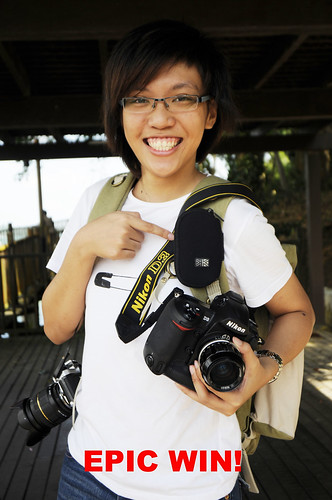
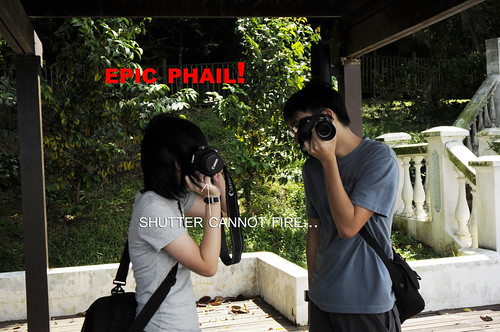
Although you didnt see XQi in the last photo, here's one more!!! (don't give Junsen any notice, please.)
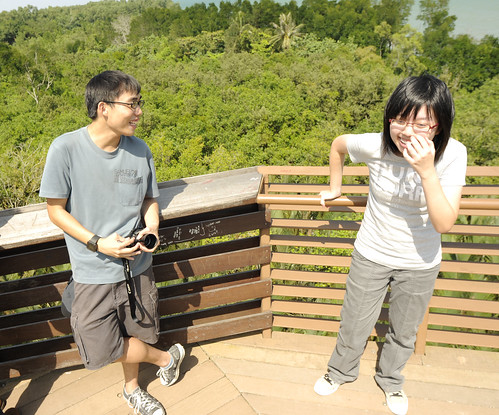
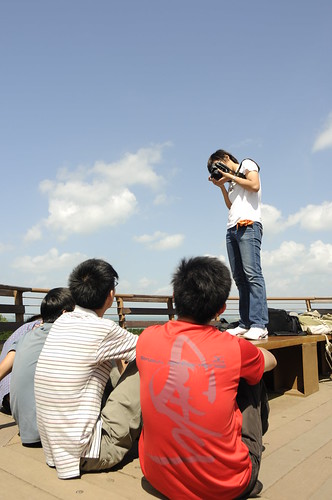
WHERE'S WALLY?
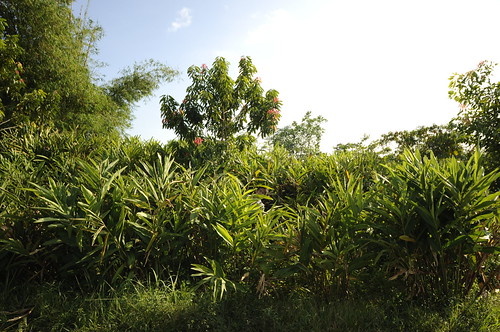

Group shot with our goggie friend!
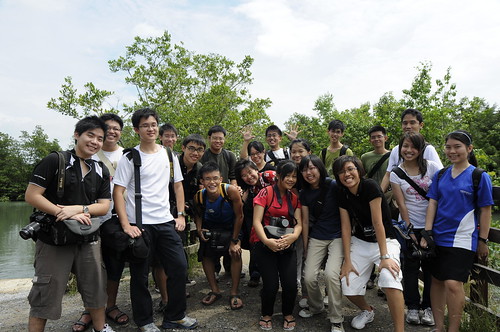
Sunday, January 4, 2009
DIY Bokeh
 Picture by : Jimmy Sng
Picture by : Jimmy SngYour Own Bokeh :)
http://www.diyphotography.net/diy_create_your_own_bokeh
I might try tonight and maybe post some pictures of the results :) Enjoy :)
Saturday, January 3, 2009
Ops Ubin: The Aftermath
It all started out with great planning by the Alumni

